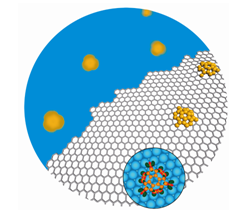| The epitaxial CVD growth on catalyst surface is the most promising method of synthesizing high quality, large area graphene. A complete growth process includes (i) the nucleation of graphene domains, (ii) the expansion the domain and (iii) the coalescence of the graphene domains into a macroscopic graphene layer. In this talk, I’m going to present our recent theoretical studies on (i) and (ii) in details and (iii) briefly:
· During the nucleation stage on most catalyst surface, C chains that have up to 8-13 C atoms are found very stable and a transition from sp1one dimensional (1D) C chain to sp2two dimensional (2D) graphene island is necessary to initiate the graphene nucleation.[1-2] The metal step was found to be the preferred site of graphene nucleation on catalyst surface and the medium sized C cluster, C21, showed exceptional stability on the catalyst surface; [3-5]
· Edge construction is crucial for graphene in vacuum, while graphene edge on catalyst prefers to maintain its pristine form. [6] While the naked graphene edge on Cu(111) surface tends to be terminated by Cu add atoms and the special passivation contribute to the fast growth rate of graphene armchair edge; [7]
· Three modes of graphene CVD growth, on terrace, near metal step, and the embedded growth are proposed and the graphene epitaxy growth or the determination of graphene’s orientation on various catalyst are carefully studied; [8-9]
· Other related topics--the formation of point defects in graphene CVD growth and the mechanism of defect healing,[10] the role of hydrogen in graphene CVD growth on Cu surface,[11, 12] and the detailed mechanism of graphene domain evolution during the growth-etching-regrowth procedure on Pt surface [13] will also be discussed as well.
[1] J. F. Gao, et. al.,J. Phys. Chem. C, 115 , 17695, (2011)
[2] J. F. Gao, et. al.,J. Am. Chem. Soc., 133, 5009, (2011)
[3] Q. H. Yuan, et. al., J. Am. Chem. Soc., 133, 16072, (2011)
[4] Q. H. Yuan, et. al.,J. Am. Chem. Soc., 134, 2970-2975, (2012)
[5]J. F. Gao, et., al.,Angew Chem-Int. Ed.,in press, (2014)
[6] J. F. Gao, et. al.,J. Am. Chem. Soc, 134, 6204-6209, (2012)
[7] H. Shu, et. al.,ACS Nano, 6, 3243-3250 (2012)
[8] X. Y. Zhang, et. al.,J. Phys. Chem. Lett., 3, 2822, (2012)
[9] Q. H. Yuan, et. al.,J. Phys. Chem. Lett., 5, 3093, (2014)
[10] L. Wang, et. al.,J. Am. Chem. Soc., 135, 4476 (2013)
[11] X. Y. Zhang, et. al.,J. Am. Chem. Soc., 136, 3040, (2014)
[12] H. B. Shu, et. al.,Chem. Sci, 5, 4639 (2014)
[13] T Ma, et. al.,PNAS, 110, 20386 (2013)

|
